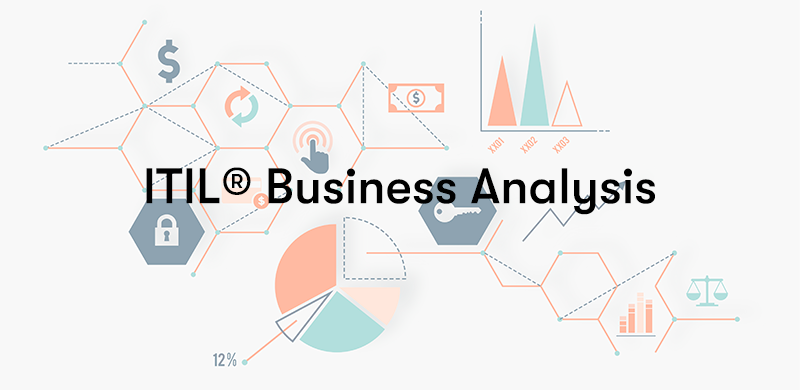ITIL 4 (Information Technology Infrastructure Library) is a framework for IT service management that provides guidance on delivering value to customers through the design, development, and management of IT services. While ITIL has traditionally focused on IT operations and service delivery, ITIL 4 expands its scope to include a broader range of practices, including business analysis.
ITIL® Business Analysis
ITIL 4 Business Analysis is a practice that helps organisations identify and articulate their business needs and requirements to enable effective decision-making and the delivery of value. It involves understanding the organisation's strategy, objectives, and processes, and translating them into clear and actionable requirements for IT solutions.
What Is ITIL Business Analysis?

The Business Analysis practice in ITIL 4 provides guidance and best practices for business analysts and those involved in analysing, defining, and managing business requirements within the context of IT service management. It emphasises the importance of collaboration and effective communication between business analysts, stakeholders, and IT teams to deliver successful IT solutions. Here are some key points about the ITIL 4 practice of Business Analysis:
Purpose
The purpose of Business Analysis is to identify, analyse, and articulate the business needs, requirements, and priorities. It aims to ensure that IT solutions and services are aligned with the strategic objectives of the business.
Scope
The scope of Business Analysis extends across the entire service value chain, covering all stages from demand and strategy to design, transition, and operation. It involves activities such as identifying business opportunities, assessing feasibility, defining requirements, and validating solutions.
Key Activities
The Business Analysis practice includes various activities, such as gathering and documenting business requirements, conducting feasibility studies, analysing existing processes, identifying improvement opportunities, facilitating workshops and meetings, and providing input to IT solution design and implementation.
Techniques and Tools
Business analysts utilise a range of techniques and tools to perform their tasks effectively. These may include stakeholder analysis, business process modelling, data analysis, requirements elicitation techniques (interviews, surveys, workshops), prototyping, and use case development.
Collaboration and Communication
Successful Business Analysis relies on strong collaboration and communication skills. Business analysts need to engage with stakeholders from both the business and IT domains, ensuring a clear understanding of requirements, managing expectations, and facilitating effective decision-making.
Relationship with Other Practices
Business Analysis has close relationships with other ITIL 4 practices. For example, it interacts with Service Strategy to align IT solutions with business objectives, Service Design to define requirements for new services, and Service Transition to ensure smooth implementation and transition of changes.
Outputs and Deliverables
Business Analysis produces several outputs and deliverables, including business cases, requirement specifications, process models, use cases, user stories, impact assessments, and feasibility reports. These artifacts provide the foundation for making informed decisions about IT solutions and services.
By leveraging the Business Analysis practice in ITIL 4, organisations can enhance their ability to understand business needs, prioritize investments, and deliver IT solutions that drive value and support the achievement of strategic goals. It promotes a holistic and business-focused approach to IT service management, fostering collaboration and alignment between business and IT stakeholders.
What Is The Objective Of Business Analysis?

The objectives of the ITIL 4 practice of Business Analysis include:
Understanding Business Needs
The primary objective of Business Analysis is to gain a deep understanding of the business needs, goals, and priorities. This involves engaging with stakeholders, conducting analysis, and identifying areas where IT solutions and services can contribute to achieving those objectives.
Aligning IT Solutions with Business Objectives
Business Analysis aims to ensure that IT solutions and services are aligned with the strategic objectives of the organisation. By analysing business requirements and translating them into IT requirements, it helps bridge the gap between business needs and IT capabilities, ensuring that IT investments deliver value and contribute to business success.
Defining and Managing Requirements
Business Analysis focuses on defining clear and actionable requirements for IT solutions and services. This involves identifying, documenting, and prioritising business and user requirements, as well as managing changes to requirements throughout the project or service lifecycle.
Enhancing Decision-making
Effective Business Analysis provides decision-makers with the necessary information and insights to make informed decisions about IT investments, solution designs, and service improvements. By analysing data, conducting feasibility studies, and assessing potential impacts, business analysts help stakeholders make decisions that align with business goals and maximize value.
Driving Continuous Improvement
Business Analysis plays a crucial role in identifying opportunities for process improvement and optimisation within the organisation. By analysing existing processes, identifying bottlenecks, and proposing improvements, business analysts help drive continuous improvement initiatives that enhance efficiency, effectiveness, and customer satisfaction.
Facilitating Collaboration and Communication
Another objective of Business Analysis is to facilitate collaboration and communication between business stakeholders and IT teams. By acting as a bridge between these two domains, business analysts ensure that there is a shared understanding of requirements, expectations, and constraints, promoting effective teamwork and minimising the risk of misalignment.
Managing Risks and Impacts
Business Analysis assesses the potential risks and impacts associated with proposed changes or IT projects. By conducting impact assessments and identifying potential risks and dependencies, business analysts help organisations proactively manage and mitigate risks, ensuring smooth transitions and minimizing disruptions to business operations.
Overall, the objectives of the ITIL 4 practice of Business Analysis revolve around understanding business needs, aligning IT solutions with those needs, defining clear requirements, enhancing decision-making, driving continuous improvement, facilitating collaboration, and managing risks and impacts. By achieving these objectives, organisations can maximize the value derived from their IT investments and deliver solutions that meet the evolving needs of the business.
Why is Business Analysis Important in The ITIL 4 Framework?

Business Analysis is important in ITIL because it provides a structured approach to understanding and aligning IT solutions with the needs of the business. It helps organisations effectively identify, define, and manage business requirements to deliver valuable IT services and solutions. Here's how Business Analysis fits into the ITIL framework:
Service Strategy
Business Analysis contributes to the Service Strategy stage by assisting in the identification and analysis of business needs, goals, and opportunities. It helps organizations understand the strategic objectives and desired outcomes, ensuring that IT investments are aligned with the overall business strategy.
Service Design
In the Service Design stage, Business Analysis plays a vital role in defining the requirements for new or changed services. It helps organisations identify and document business requirements, analyse existing processes, and translate them into clear and actionable IT requirements. This ensures that the designed services meet the needs of the business and can be effectively implemented.
Service Transition
During the Service Transition stage, Business Analysis facilitates the smooth implementation and transition of changes. It helps assess the impacts of changes, conducts feasibility studies, and ensures that the transition plans address the business requirements. By identifying potential risks and dependencies, Business Analysis supports effective change management and reduces the potential for service disruptions.
Service Operation
Business Analysis contributes to the ongoing operations by providing insights into business needs and user requirements. It helps organisations understand evolving business requirements, identify improvement opportunities, and facilitate continuous improvement initiatives. This ensures that IT services remain aligned with changing business needs and deliver optimal value.
Continual Service Improvement
Business Analysis plays a crucial role in the Continual Service Improvement (CSI) stage by identifying opportunities for improvement and analysing the impact of proposed changes. It helps organisations assess the effectiveness and efficiency of IT services and suggests enhancements based on feedback and analysis of business requirements. By incorporating Business Analysis practices into CSI, organizations can drive ongoing improvement in IT service delivery.
In summary, Business Analysis is an essential practice within the ITIL framework as it ensures that IT solutions and services are aligned with the needs of the business. It provides a structured approach to understand business requirements, facilitate effective decision-making, manage risks, and drive continuous improvement. By integrating Business Analysis into the various stages of the ITIL lifecycle, organisations can enhance their ability to deliver valuable and business-aligned IT services.
What is Important to Understand About ITIL Business Analysis?

The practice of Business Analysis in ITIL 4 is important for several reasons:
Aligning IT with Business Objectives
Business Analysis ensures that IT solutions and services are closely aligned with the strategic objectives of the organisation. By understanding the business needs and translating them into IT requirements, it helps bridge the gap between business and IT, ensuring that technology investments support and contribute to the achievement of business goals.
Maximising Value
Effective Business Analysis helps organisations maximise the value derived from their IT investments. By identifying and prioritizing business requirements, it ensures that IT solutions and services deliver tangible benefits, such as increased efficiency, improved customer satisfaction, cost savings, and competitive advantage.
Minimising Risk
Business Analysis plays a crucial role in managing risks associated with IT projects and changes. By conducting thorough impact assessments and identifying potential risks and dependencies, it enables organizations to proactively mitigate risks, minimize disruptions, and ensure successful implementation of IT solutions.
Improving Decision-making
Business Analysis provides decision-makers with valuable insights and information to make informed decisions about IT investments, solution designs, and service improvements. By analysing data, conducting feasibility studies, and assessing potential impacts, it helps stakeholders make decisions that are aligned with business objectives and based on a thorough understanding of requirements and risks.
Enhancing Collaboration
Business Analysis fosters collaboration and effective communication between business stakeholders and IT teams. By acting as a bridge between these two domains, it ensures a shared understanding of requirements, expectations, and constraints, enabling productive collaboration, reducing misunderstandings, and facilitating successful project delivery.
Driving Continuous Improvement
Business Analysis identifies opportunities for process improvement and optimization within the organisation. By analysing existing processes, identifying bottlenecks, and proposing improvements, it drives continuous improvement initiatives that enhance efficiency, effectiveness, and customer satisfaction.
Customer Focus
Business Analysis places a strong emphasis on understanding and addressing the needs of customers and end-users. By conducting thorough requirements gathering and analysis, it ensures that IT solutions and services are designed and delivered in a way that meets customer expectations, enhances user experience, and drives customer satisfaction.
Overall, the importance of Business Analysis lies in its ability to bridge the gap between business and IT, align technology with business objectives, maximise value, minimise risks, improve decision-making, enhance collaboration, drive continuous improvement, and maintain a customer-focused approach. By adopting effective Business Analysis practices, organisations can optimize their IT investments, deliver successful projects, and drive business success in today's dynamic and technology-driven landscape.
Business Analysis Roles and Responsibilities

The roles and responsibilities within the ITIL 4 practice of Business Analysis can vary depending on the organisation and the specific project or initiative. However, here are some common roles and their associated responsibilities:
Business Analyst:
- Gather and analyse business requirements from stakeholders.
- Conduct feasibility studies and assess the impact of proposed changes.
- Translate business needs into clear and actionable IT requirements.
- Document and prioritise requirements, ensuring traceability and alignment with business goals.
- Facilitate workshops and meetings to elicit requirements and drive consensus.
- Analyse and model business processes to identify improvement opportunities.
- Collaborate with stakeholders to validate and refine requirements.
- Support the design, implementation, and testing of IT solutions.
- Provide input to the development of business cases and project plans.
- Manage changes to requirements throughout the project or service lifecycle.
- Communicate effectively with both business and IT stakeholders to ensure a shared understanding.
Business Relationship Manager:
- Act as a liaison between the business and IT teams.
- Understand business strategies, objectives, and priorities.
- Identify business opportunities and emerging needs.
- Collaborate with business stakeholders to define and prioritise requirements.
- Facilitate the communication of business needs and expectations to IT teams.
- Provide guidance to business analysts and ensure alignment with business goals.
- Manage relationships with key business stakeholders.
- Assist in the development of business cases and ROI analysis for IT investments.
- Monitor and report on the satisfaction levels of business stakeholders.
Project Manager:
- Plan and execute projects that involve business analysis activities.
- Define project scope, objectives, and deliverables.
- Allocate resources and manage project timelines and budgets.
- Coordinate and manage project teams, including business analysts.
- Monitor project progress and ensure timely completion of deliverables.
- Identify and manage risks and issues related to business analysis activities.
- Communicate project status and updates to stakeholders.
- Ensure compliance with project management methodologies and standards.
Subject Matter Experts (SMEs):
- Provide domain-specific knowledge and expertise.
- Collaborate with business analysts to validate requirements and propose solutions.
- Assist in the analysis of business processes and identification of improvement opportunities.
- Contribute to the design and testing of IT solutions within their respective domains.
- Review and provide feedback on requirement documents and deliverables.
It's important to note that these roles can overlap, and in some organisations, a single individual may perform multiple roles. The specific responsibilities assigned to each role may also vary depending on the organisation's size, structure, and project requirements.
Final Notes on Business Analysis for ITIL
In conclusion, the ITIL 4 practice of Business Analysis holds immense importance in today's business landscape. It serves as a critical bridge between business and IT, ensuring that IT solutions and services align with the strategic objectives and needs of the organisation. By understanding business requirements, defining clear IT requirements, facilitating effective decision-making, and driving continual improvement, Business Analysis enables organisations to maximise the value derived from their IT investments.
Business analysts play a pivotal role in communicating business requirements in technical terms. A business analyst should be the primary source of knowledge for any requirement-related requests for information along the lifecycle of the solution, regardless of the development and delivery methods in use.
Some key roles working alongside the Business Analyst within the Business Analysis practice include the Business Relationship Manager, Project Manager, and Subject Matter Experts. Each role carries specific responsibilities related to gathering requirements, facilitating collaboration, managing projects, and providing domain expertise.
By adopting effective Business Analysis practices, organisations can enhance their ability to deliver successful IT projects, align IT with business objectives, and drive continual improvement. The practice ensures that IT solutions and services not only meet technical specifications but also address the actual needs of the business and its stakeholders.
In a rapidly evolving technological landscape, Business Analysis becomes a crucial enabler for organisations seeking to optimise their IT investments, deliver value, and achieve competitive advantage. By embracing the principles of Business Analysis within the ITIL 4 framework, organisations can navigate the complexities of today's business environment and drive innovation and growth.



